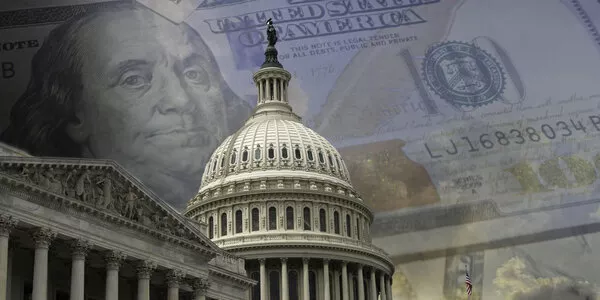
Weekly Update - Inflation in the United States: no effect of tariffs... For now
In May, US inflation continued to ease towards the Federal Reserve's 2% target. This new decrease is surprising in a context of rising customs duties and a sharp rise in inflationary expectations on the part of companies and households. However, several factors explain this figure: a destocking behaviour by companies, a certain wait-and-see attitude in the face of uncertainties about the final level of tariffs and stronger than expected disinflation in certain services. Overall, we believe that risks to inflation remain upside and should encourage the central bank to keep its monetary policy unchanged in June.
Tariffs absent from May's inflation. Inflation figures in the United States continue to show normalization towards the Federal Reserve's (Fed) 2% target, despite the increase in tariffs in April. Indeed, inflation came out at 2.4% in May against 3% at the beginning of the year while core inflation (excluding food and energy prices) stood at 2.8% against 3.3% in January. The monthly price dynamics are also favourable, with an average over the last 3 months compatible with an annual inflation rate of 2%. This disinflation is mainly due to the continued slowdown in rent inflation, the main weighting of the price index, which reached 3.9% year-on-year compared to 4.5% at the beginning of the year. Durable goods inflation, the component most affected by tariff increases, remains on a positive trend, with stable prices over one year and modest monthly increases. Emblematic of the lack of effect of tariffs, cars only posted inflation of 0.4% in May while imports are now subject to customs duties of 25%. The only items where the new tariffs are visible are electronics and toys.
Frontloading and an economic slowdown that moderate the effect of tariffs. The lack of effects of higher tariffs on inflation may be surprising, especially since all business surveys such as the ISM Manufacturing PMI indicate strong inflationary pressures. The price component of the latter is at its highest level since 2022. One of the main reasons for the absence of an inflationary effect is destocking. Companies are in the process of reducing their large inventories accumulated in anticipation of rates, which allows them to limit the increase in selling prices for the time being. A second reason would be the high uncertainty about US trade policy, both on the scale of the goods targeted and on the final effective rate. Companies would have been encouraged to delay the transmission of the increase in tariffs to prices, while waiting for a clearer picture of the stabilised customs duties. A third element that explains the low inflation is that the prices of some services are falling sharply. This decrease would be linked to a moderation in demand in a context of a slowdown in the labour market. All in all, higher inflation figures can be expected in the coming months once the storage cycle is over and the final tariff rates are set.
The Fed is expected to maintain a cautious tone in a context of continued uncertainty. The latest inflation figures are not expected to change the cautious tone of the US monetary authority. We continue to expect the Fed funds rate to remain at 4.25%-4.50% over the next few years, with a still cautious bias, with a cut only at the very end of the year. Indeed, the inflation expectations of companies and households remain very high while the effect of destocking is expected to diminish, which should increase inflation. Moreover, even though economic activity has slowed from the very strong level of 2024, growth and the labor market remain resilient, which should allow the Fed to maintain the status quo in its objective of full employment and stable inflation.
Other highlights of the week
In the highlights of the week, we chose to talk about Uncertainties over tariffs and investments in the United States and the Inflation & Monetary Policys in the US and in Europe.
Oil and gold up sharply after Israeli strikes on Iran.
On Friday, June 13, around midnight, Israel launched an attack on Iran, immediately leading to an increase in the price of oil. The price of Brent crude rose from $70 a barrel to $78.5, before falling back to $74.5 when it emerged that Israel was not targeting Iranian oil infrastructure. However, investors are worried that the conflict could lead to the blockage of the Strait of Hormuz. It is through this passage in south of Iran, that a significant part of the world's oil transits, from Saudi Arabia, Iran, Iraq, the United Arab Emirates and Kuwait. Apart from the movement observed in oil, the financial markets are showing very moderate reactions at this stage. Gold rose 1.5% at midday on Friday, exceeding $3430 an ounce. The euro-dollar remained stable after a slight jolt.
Moderate decline in sovereign spreads in Europe
Spreads in the main European countries (France, Italy, Spain) have been falling since mid-April. In Germany, the prospect of a massive issue to finance the stimulus plans has slowed down the transmission of the ECB's decision to reduce short-term rates to long-term rates, compared to other European countries. At the same time, the countries of the South are performing well. Italy managed to achieve a primary budget surplus in Q4 2024. This fiscal consolidation is reflected in its spread, which now stands at 90 basis points compared to 130 in April. As for Spain, the strong growth of 2.3% in 2024 allows the country to post a spread of 60 points. Finally, France has also benefited from a reduction in its spread, from 81 basis points in mid-April to 71 today.





